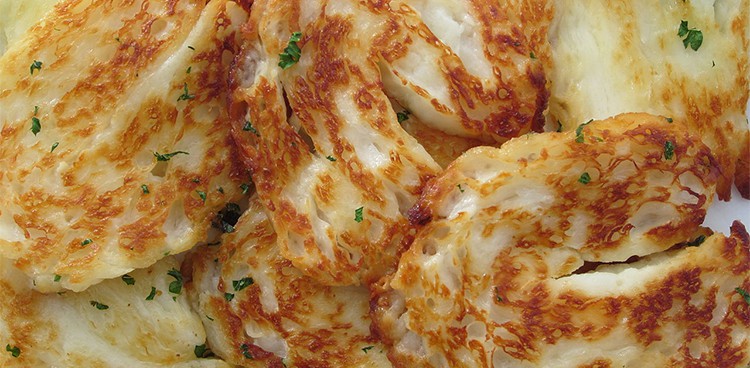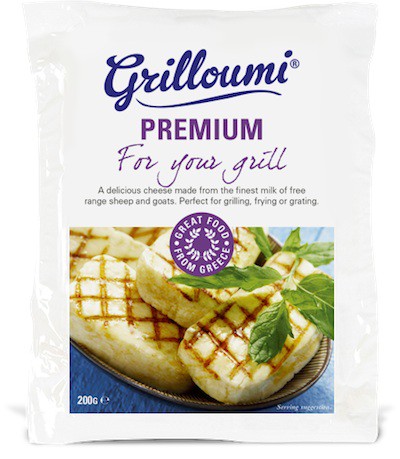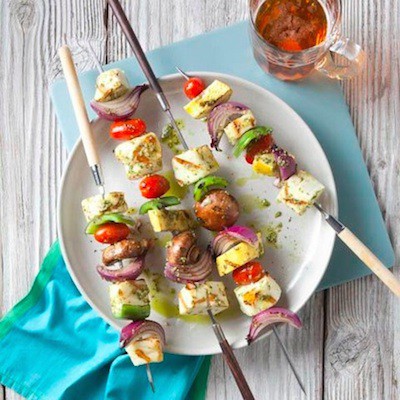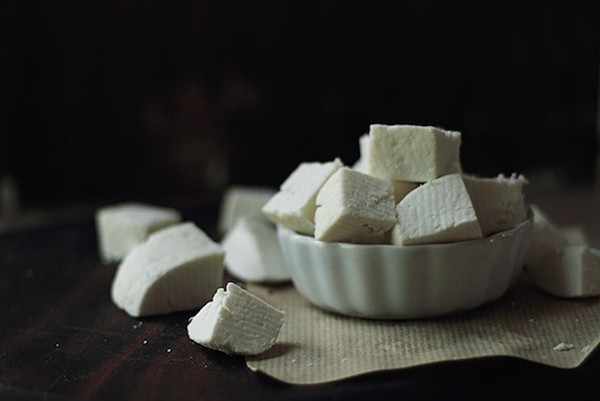
Turkey, Finland, and India all have their own versions of this squeaky delicacy. Their high melting-points make them perfect for frying up on the grill and highlighting as the star player in dishes. Read on to learn about how these cheeses are made and how to prepare them.
How It’s Made
Paneer, Halloumi, and Leipäjuusto are all similar in that they are fresh, semi-firm cheeses that can be cooked without melting. Halloumi, a middle-eastern cheese traditionally made with a mixture of goat’s milk and sheep’s milk, is remarkable in that no acid or acid-producing bacteria are used in its preparation. For this cheese, the whey used for scalding needs to be heated to about 195°F to bring out the whey proteins from the liquid. The curd is then skimmed off and drained. In Cyprus, Halloumi’s country of origin, the whey cheese is referred to as “Anari” and it closely resembles ricotta. The Halloumi is finished by being boiled in the clarified hot whey until it floats to the surface.
The preparation of Paneer differs in that some sort of acid like lemon juice, vinegar, or yogurt is added to the hot milk to separate the curds and whey. After the curds are drained and the excess water is pressed out, the paneer is bathed in cold water for two to three hours, resulting in its distinctive texture and appearance.

Halloumi has become so popular in recent years that cheesemakers are riffing on the protected-by-origin cheese.
Why Won’t it Melt?
There are several factors responsible for making theses cheeses such stubborn melters. To explain how they work, it’s important to understand what makes cheese melt in the first place. Basically, it’s all about the proteins. When cheese is heated up, the bonds holding the protein structure together start to loosen. After the bonds break, the structure of the cheese is compromised, resulting in stringy, goopy yumminess. Moisture, salt, fat, age, and acidity are all components that affect how these proteins are broken down. Cheese like Halloumi and Finnish Leipäjuusto are tricky to melt because of their low acid contents.
For Paneer, the acid used in the cheesemaking process dissolves the calcium glue that holds the casein proteins together and thus eliminates each protein’s negative electrical charge. This leaves the proteins free to clump together which help to maintain the cheese’s structure when heated. Mmm, science!
Why Does it Squeak?
The origins of some cheeses squeaky texture has been a source of debate within the cheese community. Some attribute it to the sound of air escaping from the cheese after being bitten into, but the answer is, yet again, in the proteins.
The same protein clumps created by the acid in Paneer and the rennet in Halloumi are what give these cheeses their signature squeak. The sound is coming from the long protein strands rubbing against the enamel of your teeth. The New York Times once compared the sound to a couple of “balloons trying to neck.” Next time your snack on some cheese curds, try picturing that with a straight face.

Want to make a vegetarian’s or cheese-lover’s day? Include Halloumi on your next kebab.
How to Eat it
Because they retain their shape when heated, these cheeses have what it takes to stand on their own at mealtime. Halloumi is salty with a mild flavor similar to mozzarella. It is traditionally garnished with mint both to add flavor and act as a preservative. Even though the cheese doesn’t melt, the texture does change significantly when warm. Halloumi and Leipäjuusto are dense and chewy when cold but heating them up brings them to a silky consistency while still maintaining the just the right amount of bite. Frying the cheese also gives it that crispy brown crust that’s so desirable.
Halloumi is often served with a side of vegetables or in salads while the Finnish will eat their Leipäjuusto for breakfast with a cup of coffee. Paneer is more commonly found as an ingredient in larger dishes like sandesh, rasmalai, and paneer tikka masala.




